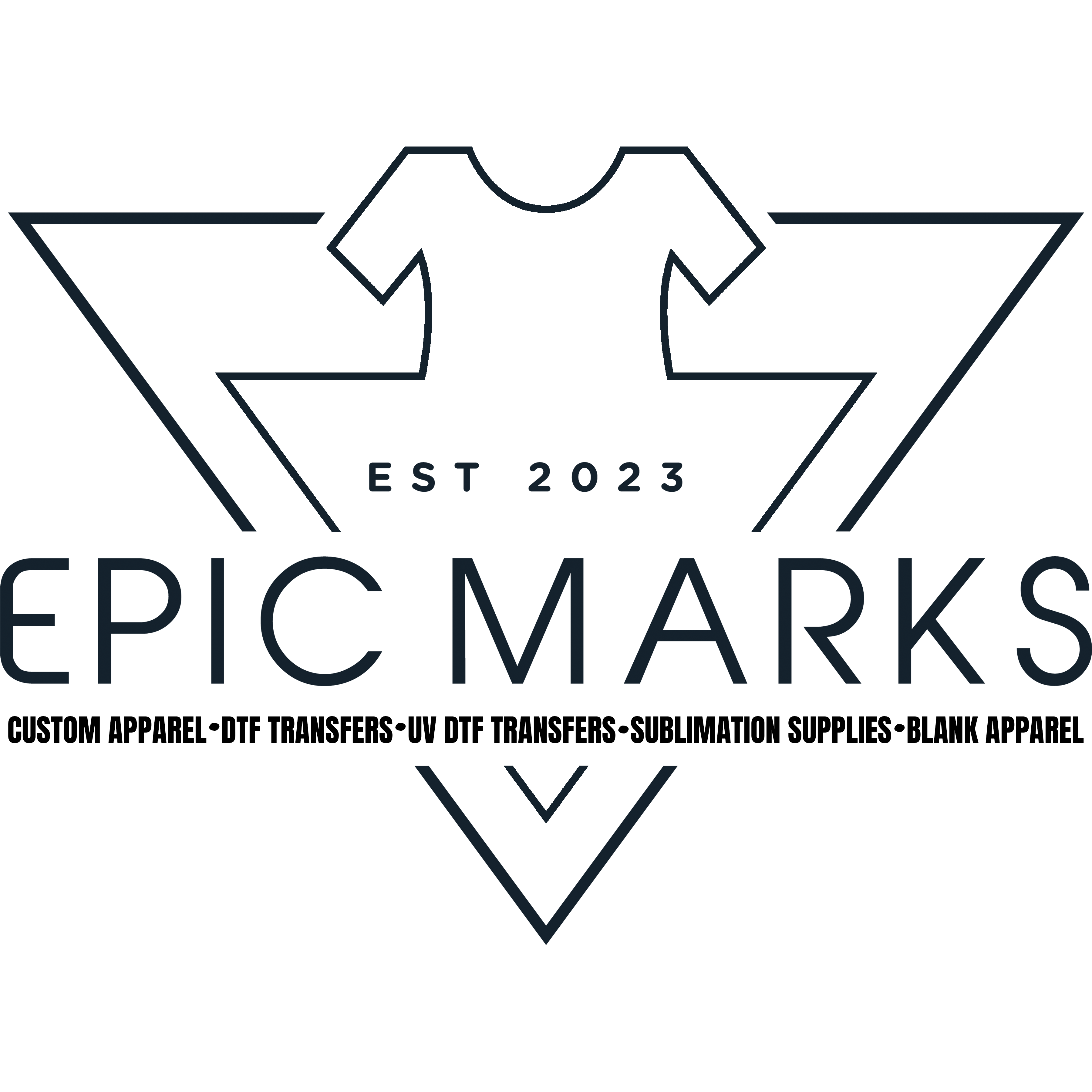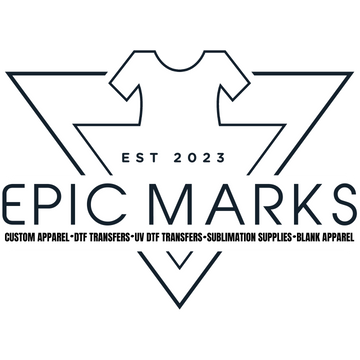Help
DTF Transfers
Press settings, common issues, and downloads.
Pressing
Recommended settings and technique.
Premium Instant Hot Peel DTF
Instant Hot Peel DTF transfers are the most common type of film we produce. They’re designed for quick production with fast peeling, but proper prep and alignment make all the difference in achieving a professional result.
Step 1: Prepare the Garment
Always start with a clean, wrinkle-free garment. Place it on the heat press and smooth it out by hand to remove folds or seams that could interfere with pressure. If the garment has thick seams, collars, or zippers, consider using a pressing pillow or pad to level the surface and maintain even pressure.
Pre-press the garment for 2–3 seconds at 260°F (127°C) with heavy pressure. This quick pre-press removes moisture and flattens the fibers so the transfer can bond properly.
Step 2: Position the Transfer
Lay the transfer film printed-side down onto the garment. Use a ruler, T-square, or center chest guide to help with alignment — crooked transfers are the number one customer complaint, so take the extra time to double check placement. A small piece of heat tape can help secure the film if needed.
Step 3: First Press
Close the press and apply heat at 260°F (127°C) with heavy pressure for 6 seconds. Even, consistent pressure across the entire surface is key — transfers may not fully bond if part of the design isn’t pressed evenly.
Step 4: Peel Film
This is where Instant Hot Peel shines. As soon as you open the press, peel the film immediately while it’s still hot. Start from a corner with the most ink coverage and pull the film back smoothly in one continuous motion, keeping it low and close to the fabric. If you peel upward or hesitate, edges may lift with the film.
Step 5: Post-Press
After peeling, cover the design with a Teflon sheet and press again at the same temperature and pressure for 4 seconds. This step improves wash durability and helps the transfer bond more permanently to the fibers.
Troubleshooting
- Image not releasing? Lower the temperature slightly to 250°F (121°C) and press again for 4 seconds. A lower temp can sometimes release the film more smoothly.
- Edges lifting? Increase pressure slightly or add a pressing pillow for garments with seams or uneven surfaces.
- Garment scorching? Reduce press time slightly — DTF films bond quickly and don't require long dwell times like vinyl.
Pro Tip: If you are pressing in bulk, every 20–30 presses, check your heat press temperature with a surface thermometer to ensure it hasn’t drifted hotter or cooler than the display indicates.
Metallic DTF
Metallic DTF transfers — including Gold, Silver, and other specialty finishes — create a bold, reflective shine. They press just like standard transfers, but with slightly higher heat, a longer press time, and a cold peel process for best results.
Step 1: Prepare the Garment
Start with a clean, wrinkle-free garment. Lay it flat on the heat press and smooth it out by hand. Pre-press for 2–3 seconds at 260°F (127°C) with heavy pressure to remove moisture and prepare the fibers for bonding.
Step 2: Position the Transfer
Place the metallic transfer film printed-side down. Metallics highlight placement more than standard films, so take extra care to line it up straight using a ruler or center guide. Secure with a small piece of heat tape if needed.
Step 3: First Press
Press at 284–302°F (140–150°C) with medium pressure for 8–10 seconds. Apply consistent, even pressure across the entire design to activate the metallic finish.
Step 4: Peel Film
Remove the garment from the press and allow it to cool completely before peeling. Once cool, peel slowly from a corner in a smooth, low-angle motion. Peeling early or too quickly can cause flaking.
Step 5: Post-Press
Cover the design with a Teflon sheet and press again at the same temperature and pressure for 3–5 seconds. This step locks in the shine and improves durability through washing.
Troubleshooting
- Flaking or residue? Ensure the transfer was fully cooled before peeling. After post-press, remove stray flakes gently with a lint roller.
- Edges lifting? Re-press for 3–5 seconds with a Teflon sheet, adding slightly more pressure if needed.
Pro Tip: Metallic films perform best on bold logos, text, and simple shapes. Avoid fine details, which may not transfer cleanly and reduce reflectivity.
Glitter DTF
Glitter DTF transfers add sparkle and texture to your designs. They press like standard transfers but require a cold peel — meaning you must let the garment cool completely before removing the film.
Step 1: Prepare the Garment
Start with a clean, wrinkle-free garment. Lay it flat on the press and smooth it out by hand. Pre-press for 2–3 seconds at 260°F (127°C) with heavy pressure to remove moisture and prepare the fibers for bonding.
Step 2: Position the Transfer
Place the glitter transfer film printed-side down on the garment. Glitter has a thicker feel, so alignment matters — double-check placement with a ruler or alignment guide. A small piece of heat tape can keep it steady.
Step 3: First Press
Press at 260°F (127°C) with heavy pressure for 6 seconds. Apply even pressure across the full transfer so all glitter particles adhere properly.
Step 4: Peel Film
Remove the garment from the press and set it aside until it has cooled completely. Once fully cool, peel the film slowly from a corner in a smooth, low-angle motion. Peeling early will cause glitter to lift.
Step 5: Post-Press
Cover the design with a Teflon sheet and press again at the same temperature and pressure for 4 seconds. This step locks in the glitter and makes it more wash-resistant.
Troubleshooting
- Film won’t release? Wait longer — the transfer must be fully cooled before peeling.
- Edges lifting? Increase pressure slightly or add a pressing pillow if seams are interfering with even contact.
Pro Tip: Glitter transfers look best on bold logos, numbers, and statement graphics. Fine lines or tiny details won’t sparkle as well and may be harder to peel cleanly.
Glow-in-the-Dark DTF
Glow-in-the-Dark DTF transfers absorb light and shine in dark environments. They press like other cold-peel films, but special care ensures you get the strongest glow effect.
Step 1: Prepare the Garment
Lay the garment flat on the heat press and smooth it out. Pre-press for 2–3 seconds at 260°F (127°C) with heavy pressure to remove moisture and flatten the fabric surface.
Step 2: Position the Transfer
Place the glow transfer film printed-side down. Because glow prints are often used for bold designs, take your time to align them square and centered. Use rulers or an alignment guide for accuracy, and heat tape if needed.
Step 3: First Press
Press at 260°F (127°C) with heavy pressure for 6 seconds. Apply firm, even pressure to ensure the glow pigments bond fully.
Step 4: Peel Film
Let the garment cool completely before peeling. Once cool, peel the film back smoothly from a corner in one continuous motion. Peeling early can damage the glow layer.
Step 5: Post-Press
Cover with a Teflon sheet and press again at the same settings for 4 seconds. This step helps seal the glow material and increases wash life.
Troubleshooting
- Film hard to peel? Wait longer — glow films need a full cool-down cycle.
- Glow effect looks weak? Charge the print under bright light for at least 1–2 minutes before viewing. Glow intensity may vary by fabric type.
Pro Tip: For the most dramatic glow, apply transfers to light or white garments. Dark fabrics may reduce brightness of the glow effect.
Troubleshooting
Film & Adhesion Problems
These are the issues you’ll see right at the press — transfers not sticking, edges lifting, or the film refusing to release.
Edges Lifting or Not Sticking
If corners of the design lift after pressing, pressure or garment prep is usually the culprit.
- Increase pressure slightly and re-press with a Teflon sheet for 4–5 seconds.
- Make sure no seams, collars, or zippers are interfering with even pressure. Use a pressing pillow if needed.
Film Not Releasing
When the transfer won’t peel away cleanly from the film:
- Hot Peel films: Peel immediately while hot — don’t wait.
- Cold Peel films: Wait until fully cool. Rushing this step causes sticking.
- Still stuck? Drop press temp slightly (around 250°F / 121°C) and press again for 4 seconds.
Pro Tip: Always give transfers a quick post-press with a Teflon sheet. It’s cheap insurance against lifting or peeling later.
Print Quality & Color Issues
If your transfers press but don’t look right — dull, flat, or ghosted — check these areas first.
Colors Look Dull or Faded
- Check your actual press temp with a surface thermometer. Don’t rely only on the digital readout.
- Under-pressing leads to chalky, faded colors. Over-pressing can flatten the ink and kill vibrancy.
Ghosting or Shadowing
A faint duplicate image usually means the film shifted during pressing.
- Smooth the transfer before pressing and use heat tape to keep it locked in place.
- Lower the press slowly and evenly — snapping it shut can cause movement.
Pro Tip: When in doubt, run a test press on scrap fabric. A 10-second test can save you from wasting transfers.
After-Wash & Durability Problems
Sometimes transfers look great off the press but fall apart after a few washes. Here’s how to prevent that.
Cracking or Peeling After Wash
- Always do a second press with a Teflon sheet for 4–5 seconds to lock in adhesion.
- Make sure your pressure is firm and even — weak pressure leads to poor wash durability.
Customer Care Mistakes
Even a perfect press won’t survive if the garment is washed wrong.
- Wash inside-out in cold water with mild detergent.
- Avoid bleach, harsh detergents, and fabric softeners.
- Tumble dry low or hang dry for best results.
Pro Tip: If you’re selling decorated garments, include a printed care card in the order. It cuts down on “user error” complaints. (grab ours from the download section below)

